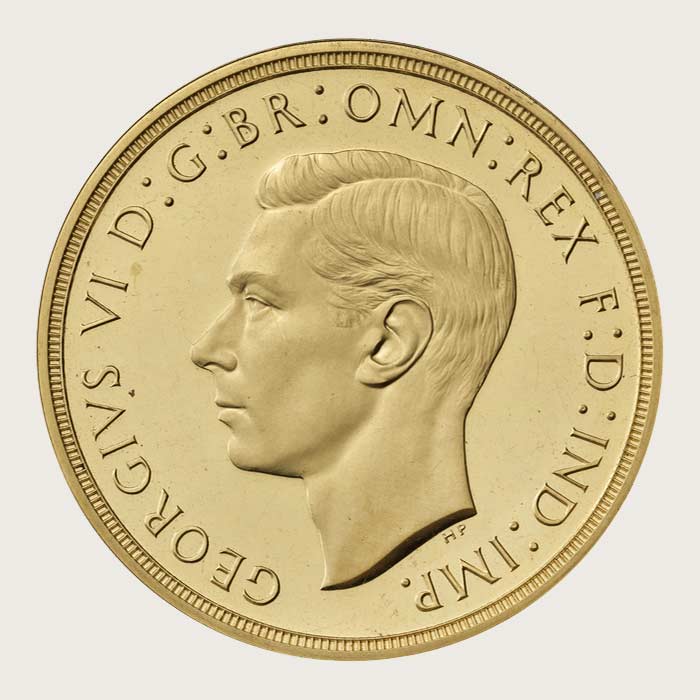First introduced to United Kingdom coinage in 1969, the 50p coin has become an iconic piece of British history. Today, the 50p is used to commemorate historical occasions and has inspired many to start collecting, with the coin often credited as the gateway coin to starting a collection. The third coin issued as part of the decimalisation programme, the 50p coin has featured four definitive portraits of Queen Elizabeth II, from its inception up until her passing in 2022.
The preparation for decimalisation was well underway when the first 50p coin was introduced to the UK. Designs for a coin to replace the 10-shilling note were considered by the Royal Mint Advisory Committee throughout 1967 and 1968. The notes by this point were only lasting for approximately five months at a time in circulation and it was thought that a coin, which could last for up to 50 years, would be a better choice.
After much consultation, the 50p coin was created, becoming the first seven-sided equilateral curve heptagonal coin in the world. The new coin needed to be easily distinguishable from other coins in a person’s pocket and it also needed to roll easily in vending machines, which were starting to rise in popularity.
The 50p coin faced some adversity from the general public when it was first released, with some even creating an ‘Anti-Heptagonist’ movement to oppose it.
Members of the public at first felt that the coin was too similar to the new 10p; however, people soon became used to the new shape. It was then replaced with a smaller 50p coin in 1997, with the older, larger coin becoming demonetised in 1998.
As well as featuring the classic design of Britannia by Christopher Ironside, the 50p coin has been used to commemorate historical anniversaries. Some of these designs have been released into general circulation, depending on the requirements of British banks, with the rarest 50p design still in circulation being that of Kew Gardens in 2009. Only 210,000 50p coins bearing the Kew Gardens design were released into circulation, making it one of the most sought-after coins today.

Arnold Machin RA
With the introduction of new decimal coinage, it was decided that a new portrait was needed to replace Mary Gillick’s iconic work. This new portrait would help the public to distinguish between the new and old coinage to make the transition easier.
Arnold Machin RA’s effigy was chosen, with The Royal Mint Advisory Committee feeling that it showed a more beautiful depiction of Queen Elizabeth II out of all the designs submitted at the time. Machin’s effigy featured on UK coinage from 1968 until 1984 and was the first of Elizabeth II’s portraits to be struck on a 50p coin in 1969. Machin’s work featured an ‘uncouped’ portrait which showed the monarch’s shoulders, similar to the Gillick portrait.

Raphael Maklouf
Raphael Maklouf was selected to design the third definitive portrait of Queen Elizabeth II in 1982. Maklouf based his work on photos taken by Lord Snowdon and was granted two sittings with the Queen to refine his work, with the aim of creating an ageless portrait to show Elizabeth II as a regal symbol.
Maklouf’s portrait was the first to show a ‘couped’ design, and featured a necklace, earrings and the royal diadem that Queen Elizabeth II wore to the State Opening of Parliament. This third definitive portrait was on British coinage from 1985 until 1997.

Ian Rank-Broadley FRBS
The fourth definitive portrait of Queen Elizabeth II was designed by Ian Rank-Broadley FRBS. Rank-Broadley wanted to feature a more realistic design that would convey the wisdom and poise of the monarch. He designed his effigy to fill as much of the coin as possible, featuring a ‘couped’ design. Rank-Broadley’s work featured on UK coinage from 1998 until 2015.

Jody Clark
The last definitive portrait of Queen Elizabeth II to feature on British coinage was designed by Jody Clark and featured on the 50p coin from 2015 until the last year of her reign in 2022. Jody Clark was the first designer from The Royal Mint to design a definitive coinage portrait for more than 100 years. This final portrait featured a ‘couped’ design with a hint of a smile.
Queen Elizabeth II 50p Effigies Set Discover all 50p Fifty Pence








